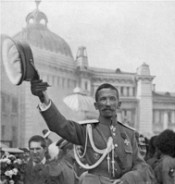
The Kornilov Coup was suppressed
August 31 (September 13), 1917 ended an unsuccessful coup attempt led by the Russian Supreme Commander in Chief, General L. G. Kornilov.
In the summer of 1917, Russia was in a deep political and socio-economic crisis. The provisional government proved unable to solve the main problems the country was facing. Clashes around the key issue of Russia's participation in the World War I led to another shock - the July crisis, which put an end to the dual power of the Provisional Government and the Petrograd Soviet. In the complex and chaotic situation in the country, right-wing forces persistently looked for a strong personality, able to do away with "anarchy." General Kornilov seemed to be this kind of person. It was him who replaced General A. A. Brusilov at the post of the Supreme Commander in Chief of Russia on July 19 (August 31). Kornilov, who enjoyed great popularity in military circles, started to take stringent measures to restore order in the army immediately after the appointment.
II coalition government under the chairmanship of A. F. Kerensky, formed July 26 (August 6), tried to pursue a policy of maneuvering between the main political forces in the country, which, however, caused discontent in both camps. In order to finally be free from the control of the Soviets, to make a favorable impression on the conservative forces and provide broad support to his government, criticized by both the left and the right, Kerensky accelerated the formation of new state institutions. 12-15 (25-28) August in Moscow a State Conference took place. Speaking at the conference, Kornilov called legislative measures, taken after the overthrow of the monarchy, the main cause of the collapse of the army. General and circles close to him had already prepared an agenda for change in the country, which included measures to restore the disciplinary authority of commanders in the army and navy, limit the rights of soldiers' committees, a ban on rallies and strikes in the army at war plants, introduce martial law in all railways, factories and mines, working for the front, as well as the extension of the death penalty in the rear. According to the program, the country was to be headed by the Council of National Defense, chaired by Kornilov, with Kerensky as his deputy.
After the defeat of the Russian troops in the operation of Riga, and Riga’s fall on August 21 (September 3), Kornilov began negotiations with Kerensky. Conducting the talks through intermediaries, Kornilov tried to achieve a peaceful transition of all the power to him. Meanwhile, the general did not exclude a possibility of establishing "individual or collective" dictatorship. 25 August (7 September) Kornilov moved his troops to Petrograd, demanding the resignation of the Provisional Government and departure of Kerensky to GHQ. August 27 (September 9) ministers Cadets, expressing solidarity with Kornilov, resigned. The main fighting force of Kornilov was the 3rd Cavalry Corps of General A. M. Krymov, who was to enter the capital to "establish the order." In response to the Kornilov’s ultimatum, Kerensky announced the general a rebel and dismissed him from the post of the Supreme Commander.
The plan to capture Petrograd using Krymov’s troops failed. Owing to actions of the Soviets of Belarus, the headquarters were cut from the front. August 29 (September 11), the Executive Committee of the South-Western Front arrested Commander A. I. Denikin. Following this, the army committees of all the armies of the front arrested their commanders - Generals Lukomsky, Markov, Romanovsky, Erdely and others. Other supporters of Kornilov at the front and in a number of cities were also isolated. August 31 (September 13) General Krymov, having learned about the failure of the rebellion, shot himself. It was the day when the Elimination of the Kornilov movement was officially announced. 2 (15) September 1917 Kornilov was arrested, and along with his supporters was imprisoned in the town of Bykhov.
Bolsheviks had played an important role in the defeat of the Kornilov Coup. After RSDLP (b)’s appeal to workers and soldiers of Petrograd to defend the Revolution, made on August 27 (September 9), about 15, 000 men enrolled the Red Guards, and after the failure of the Kornilov Coup started the period of mass Bolshevisation of Soviets. August 31 (September 13) Petrograd Soviet, and 5 (18) September the Moscow Soviet adopted the Bolshevik’s resolution “On power."
1 (14) September 1917, Russia was proclaimed a republic, and the rule was given to the Directory of five members headed by Kerensky.
Lit.: Иванов Н. Я. Контрреволюция в России в 1917 году и ее разгром. М., 1977; Он же. Корниловщина и ее разгром: Из истории борьбы с контрреволюцией в 1917 г. Л., 1965; Керенский А. Ф. Прелюдия к большевизму. М., 2006; Он же. Русская революция. 1917. М., 2005; Революционное движение в России в августе 1917 г. Разгром корниловского мятежа: Документы и материалы, М., 1959; Старцев В. И. Крах керенщины. Л., 1982; Суханов Н. Н. Записки о революции: В 3 т. М., 1991; Троцкий Л. Д. История русской революции: В 2 тт. Т. 2. М., 1997.
Based on the Presidential Library’s materials:
Kornilov affair // Section of the digital collection «1917».

